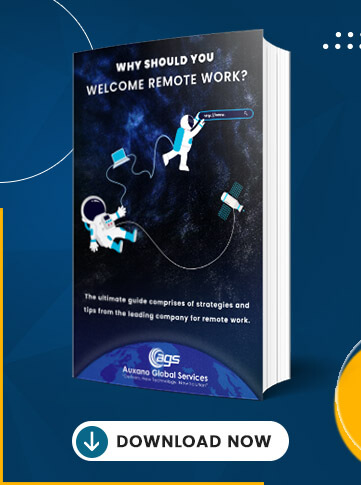The demand for bespoke software development is surging, and property management software is no exception. Real estate owners often look for a way to streamline their rental processes, making tracking tenants, collecting payments, and managing maintenance easier.
Developing custom property management software can require specialized skills and is considered a complex task, but it is achievable. In this article, we’ll discuss the stages of property management software development and many other crucial aspects you must consider when building custom software.
Before we dive into the software development details, let’s look at some of the essential real estate statistics to understand this industry better:
Real Estate Market Statistics:
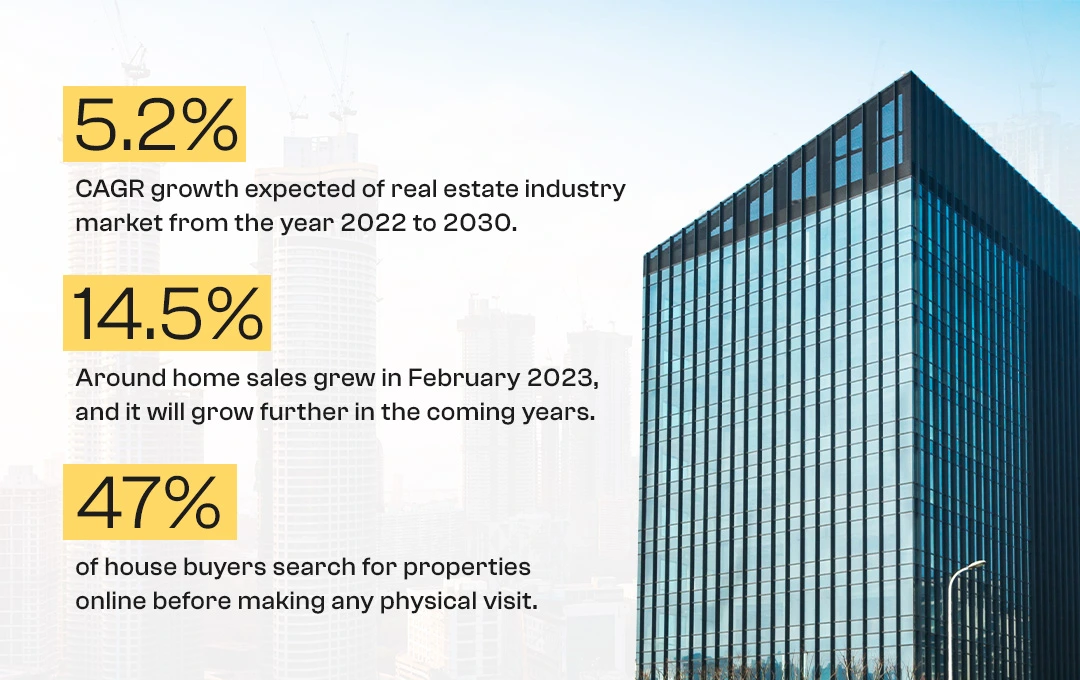
- According to reports, the worldwide real estate industry market was hovering at around $3.69 trillion in 2021. It’s expected to grow with a CAGR of around 5.2% from the year 2022 to 2030. It’s because of the rising demand for rental property, especially in developed countries like the US and Canada.
- In February 2023, existing home sales grew by around 14.5%, the biggest monthly growth since July 2020. This real estate growth figure will grow further in the coming years.
- Around 47% of house buyers search for properties online before making any physical visit. Furthermore, 21% of homeowners sell their houses to move closer to their loved ones.
Looking at the statistics, it’s easy to understand why real estate owners are looking for software development solutions. Now, let’s look at the top reasons why the real estate industry is booming at a rapid rate.
Why is The Real Estate Industry Growing At a Rapid Speed?
It’s crucial first to understand why the real estate industry is growing rapidly. Post-COVID, the real estate market has gained momentum. Here are some of the most common reasons for this growth:
- Increased Demand for Affordable Housing: The COVID-19 pandemic has greatly impacted people’s finances, and many are now looking for affordable housing solutions to reduce their financial burden. Furthermore, millennials are now looking for large spacious houses in good locations as they’re getting married and planning to have children.
- Low Mortgage Rates: Mortgage rates are at an all-time low, making it easier to buy a house than before. In addition, lenders are now more willing to provide a loan, making it possible for many individuals to purchase their dream homes.
- Growing E-commerce Industry: The e-commerce industry is growing at a rapid rate, and many businesses are now looking to expand their business presence in different locations. Thus, the requirements for commercial real estate are increasing too.
- Better ROI: Investment in real estate is one of the most common ways to make a profit. Property values are increasing, and investors are now looking for better returns on their investments by investing in the right properties.
With the growing demand, here comes the requirement for an efficient property management system. Let’s first understand what exactly is real estate management software.
What Is a Property Management System?
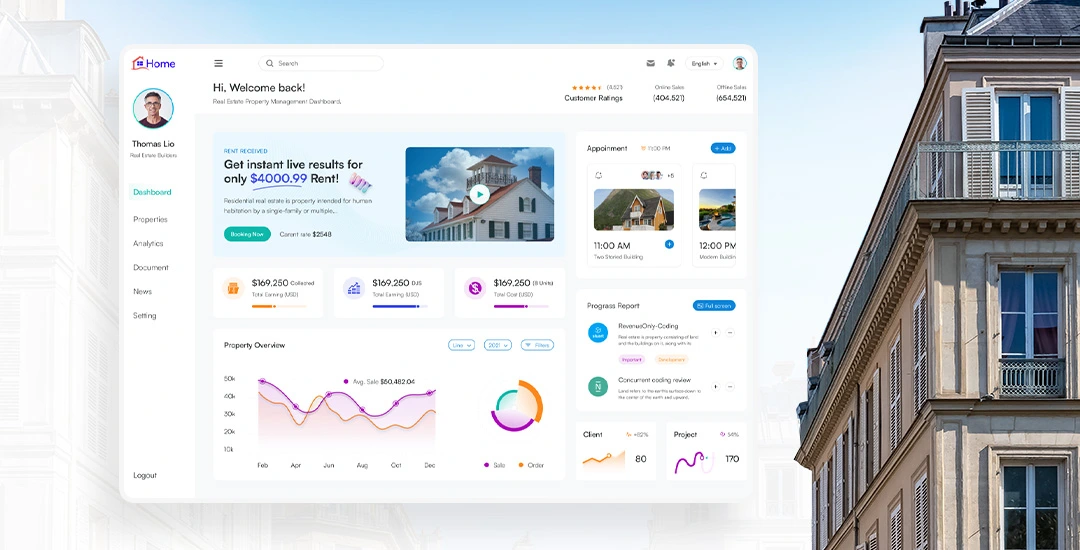
Before hiring dedicated software developers, it’s important to understand a property management system (PMS). It’s software that helps real estate owners and renters manage their properties efficiently by automating their rental processes, making tracking tenants, collecting payments, and overseeing maintenance easier.
Property management software can also be used for managing leases, rent collection, security deposits, and more. It also integrates with other software systems, such as accounting software and customer relationship management (CRM) software, to provide better insights into your business.
The most significant advantage of using a property management system is that it eliminates manual errors, saving time and resources. Also, the software can help you keep track of all activities happening at the property, such as lease renewals and tenant payments.
Be it a hospitality chain or a single property owner, developing the right property management software is critical to ensure better customer satisfaction. On this note, let’s first understand whether you should go for custom-built software or use readily available tools to manage your properties.
Use a Ready-made Or Custom-built PMS Solution?
When it comes to managing properties, real estate owners are faced with the decision of whether they should use a ready-made or custom-built property management system (PMS). While both solutions have advantages and disadvantages, understanding their differences can help you make an informed decision.
A ready-made PMS is typically cheaper than a custom solution as it is already built and tested. However, these systems may only offer some of the features that you require for your particular business model.
On the other hand, a custom-built PMS gives you more control over how your system works and allows you to tailor it specifically to meet your needs. It offers greater flexibility in terms of customization options and scalability.
When To Use a Readily Available PMS Solution?
A ready-made PMS solution is ideal for real estate owners who prefer a simple system without any complicated features. It’s also suitable for those on a tight budget who are willing to invest in something other than a custom-built solution.
When to use custom property management software?
Custom property management software benefits real estate owners who want to gain a competitive advantage in their market. It also offers greater flexibility regarding features and scalability, which is ideal for larger businesses or those that expect their needs to change over time.
In several aspects, developing a custom PMS brings multiple benefits. Development teams can design a unique solution for the specific real estate, ensuring all features fit into the property’s business model. Let’s look at some of the transforming benefits of a custom PMS.
Top 5 Benefits Of a Custom Property Management System
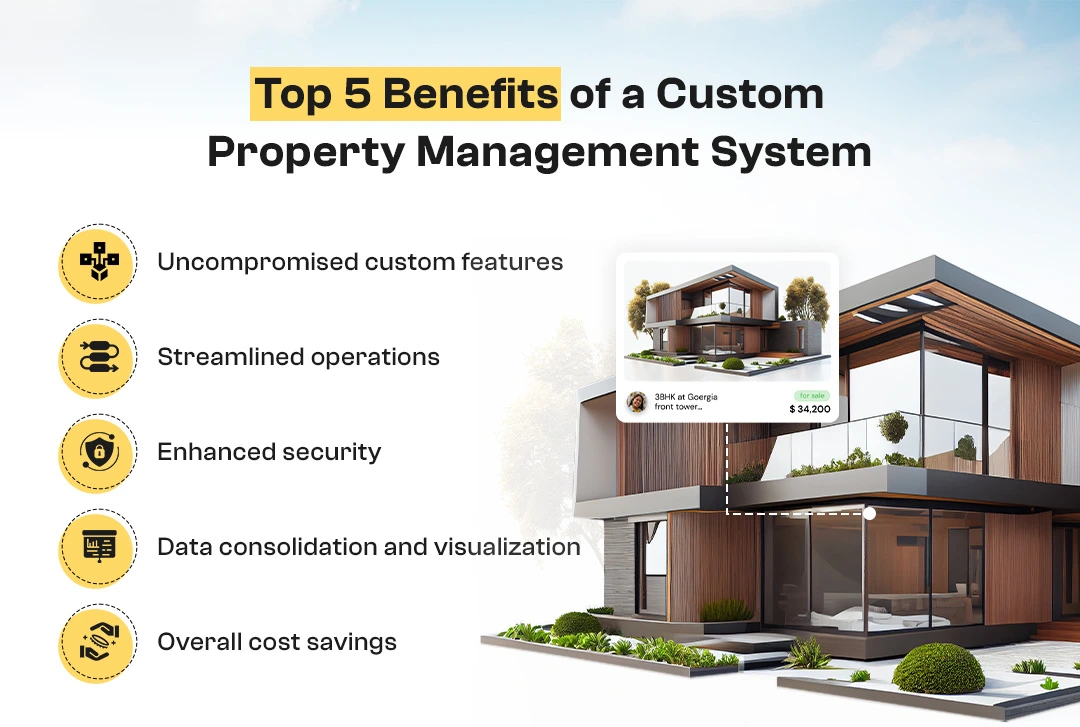
With proper planning, custom-built property management software can have a huge impact on the profitability of real estate owners. Here are some of the most prominent benefits that they should expect to achieve:
Uncompromised Custom Features:
One of the key advantages of a custom PMS is that you can tailor it to meet your individual requirements. This means developers can adjust the software to fit your business model, providing features designed with your customers in mind.
Compared to conventional pre-built software, you can have a solution that best meets the needs of your property. Moreover, adding new features as your business grows and evolves is possible. For example, if you want to add a new payment gateway, developers can easily integrate it into your already existing system.
Streamlined Operations:
Custom software is designed to streamline operations, allowing you to manage your property with ease. You can handle everything from one centralized platform, from tracking lease renewals to collecting rent payments.
Furthermore, the right custom PMS enables you to serve your customers better by providing the features and services that they need. Not only does this ensure a smooth and efficient customer journey, but it also helps strengthen customer relationships.
Enhanced Security:
Custom software is designed to be more secure than ready-made solutions. Developers can incorporate the latest encryption techniques and security measures to protect your data from unauthorized access. This is important, as the safety of customer data must be a priority for any real estate owner.
By using robust technologies like blockchain, it’s possible to give customers peace of mind that their data is safe and secure. With distributed ledger technology, real estate owners can store their data securely and reduce the risk of cyber attacks.
Data Consolidation And Visualization:
Custom property management software can collect data from different sources, allowing you to gain a 360-degree view of your property. With this data, you can quickly identify areas where improvements should be made and take steps to optimize operations.
Using advanced analytics and reporting capabilities, you can also create useful visualizations to track trends and analyze performance. This can help real estate owners make better decisions and gain an edge in their market.
Overall Cost Savings:
With the help of the best software development team, real estate owners can save money by avoiding the costs associated with pre-built PMS solutions. By investing in a custom solution, you can also save time and money on upgrades and maintenance.
Moreover, the platform always remains relevant as it is easy to upgrade it according to the changing needs of your business. This means that you can always keep up with the latest trends in property management, delivering better services to your customers.
On this note, let’s explore some crucial scenarios where building a bespoke PMS will bring multiple advantages to your business.
Scenarios Where Building a Custom PMS Solution Makes More Sense:
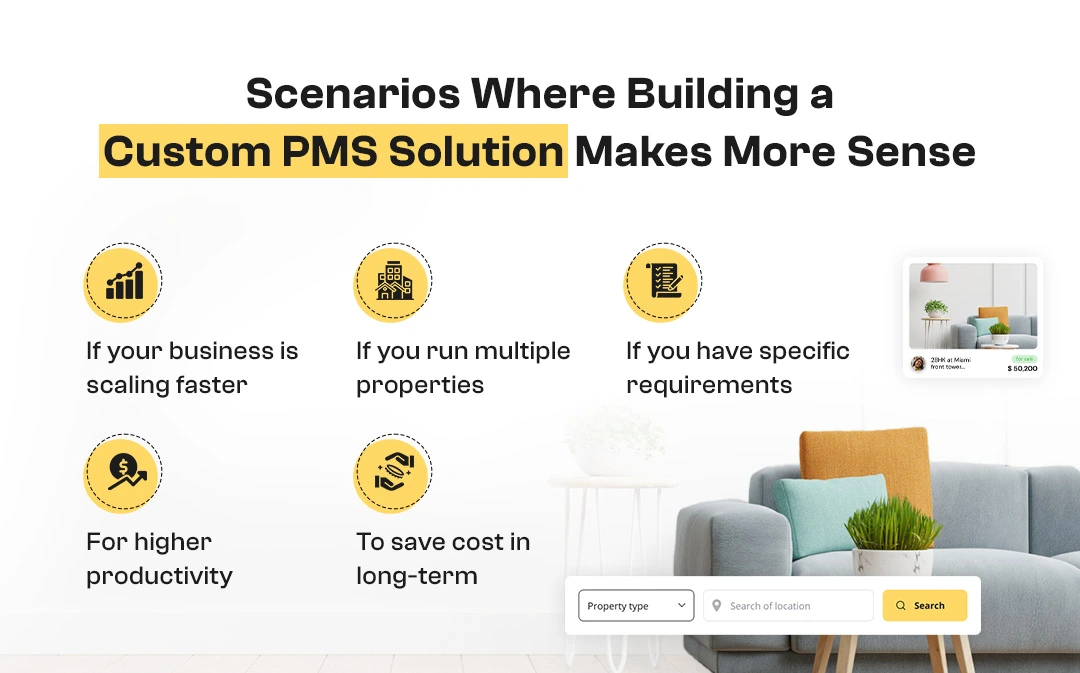
Building a custom property management system can be ideal in multiple scenarios. Below are some of the most common scenarios that may warrant the need for a custom PMS solution:
If Your Business Is Scaling Faster:
If your business is growing quickly, a custom PMS can be built to meet the rising needs of your organization. It also allows you to add features that may not be available in off-the-shelf PMS systems. This could include features that are specific to your business model or industry, including advanced reporting capabilities, complex payment systems, or particular integrations with other software.
If You Run Multiple Properties:
If your business manages multiple properties, you may need a PMS that can handle the complexity of managing multiple sites. A custom PMS will be able to manage all the different facets of your business operations and allow you to easily track and monitor each property’s performance from a single dashboard.
If You Have Specific Requirements:
Some businesses may have specific needs or requirements for their property management system that require a highly customized solution. This could include specific integrations with other software, complex payment systems, or advanced reporting capabilities. A custom PMS can be built to meet those unique needs and provide the exact features you need for your business.
For Higher Productivity:
Custom PMS solutions are also ideal for businesses that require higher productivity from their property management system. A custom PMS can be built to have automated processes and features, making it easier to manage multiple properties or tasks at once. This can drastically improve efficiency and reduce time spent on manual tasks. Moreover, it becomes easier to manage bigger teams as the custom PMS can be built to cater to such needs.
To Save Cost In the Long-term:
In many cases, a custom PMS solution can save your business money in the long run. This is especially true if you manage multiple properties or have niche-specific needs. A custom PMS solution can be built to meet those unique requirements while also being cost-effective in the long run. As it will also save a significant amount of time, you can avoid costly workforce and time spent on manual tasks.
After exploring the scenarios, let’s look at how to get started with developing property management software for your business.
How To Develop a Custom Property Management System?
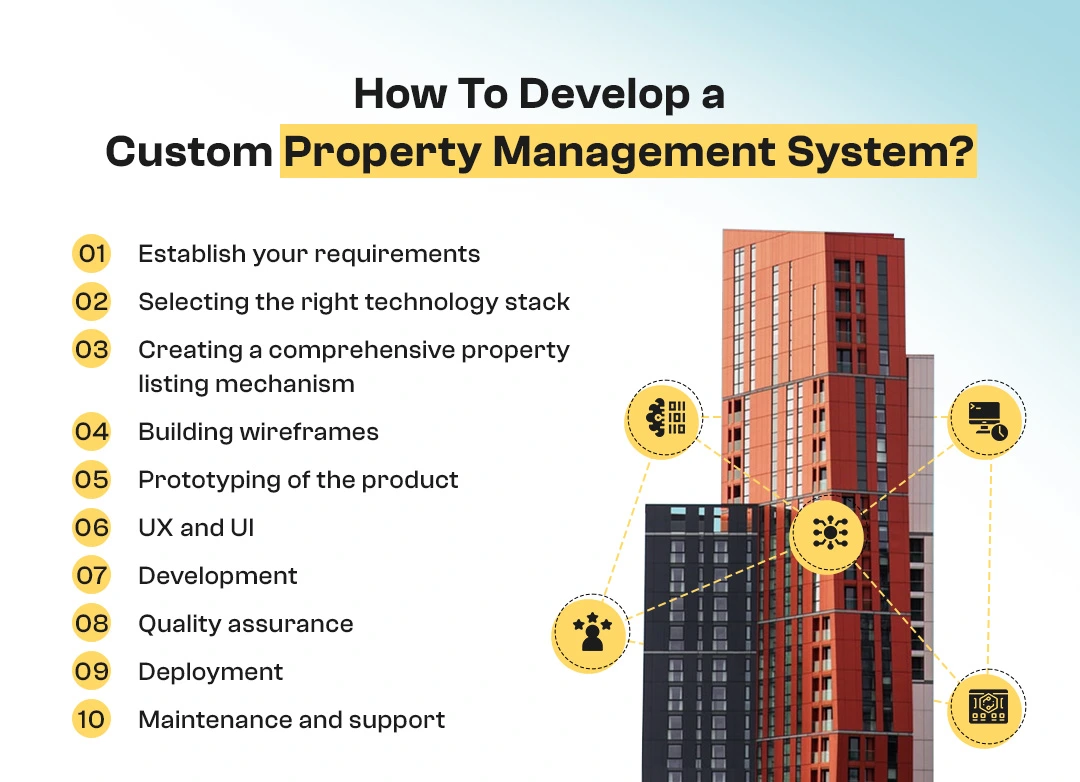
The software development process for creating a custom property management system requires knowledge of the market, an understanding of user needs and preferences, and the ability to design effective software architecture. This process involves designing software with the latest technologies, integrating existing systems and databases, and testing the system to ensure it meets the needs of users. Let’s dive into the details of how to develop a custom property management system.
Establish Your Requirements:
Before you begin development, establish and document your system requirements. Work with stakeholders to understand their goals and needs for the system and document any additional desired features and functionalities. These should include user-specific features, such as the ability to search and sort data or generate reports.
For gathering requirements efficiently, also look at what competitors are offering in their property management systems. Look at what features they are offering and build a list of essential features that should be included in your system. It’s crucial that you clearly define the requirements prior to development.
You can also conduct user research to understand the specific needs of your end-users. This will help you design a system that best meets their needs and preferences. Furthermore, you can research potential integrations with existing systems, databases, or other software that may benefit your PMS.
Selecting The Right Technology Stack:
Before you can start coding, decide on the technology stack that will drive your system. The technology stack should be based on the features and functionality required by your stakeholders. Consider the scalability needed for future growth and choose technologies accordingly. Commonly used technologies include Java, PHP, Python, Ruby on Rails, AngularJS, React, and Node.js.
In addition, developing software architecture is an important step. This will define the system’s overall design and determine how different modules interact with each other. It involves designing the system’s logical and physical components, such as databases, web services, user interfaces, and business logic. It is essential to create an architecture that is scalable, secure, and easy to maintain.
Creating a Comprehensive Property Listing Mechanism:
Property listing is one of the key aspects of a property management system. The system should be able to store, manage, and display information about rental properties in an organized manner. This includes details such as location, price range, number of bedrooms, bathrooms, amenities, etc.
The property listing feature should allow users to search for properties using various criteria and should include features such as sorting, filtering, and comparison tools. Develop the system to ensure that all data is secure, up-to-date, and accurately displayed.
In addition, building a multi-listing feature is another essential aspect of the system. This will allow users to search for properties across multiple listing sites, such as Airbnb and Rent.com.
Building Wireframes:
Wireframes are the blueprints for a user interface. They provide a visual representation of how users will interact with the system. Once you have identified the user’s objectives, create wireframes to visualize each feature and function of your property management system.
Creating these wireframes will help in making sure that all elements are correctly placed and integrated into the system. This will also enable developers to understand better how each component should look and behave. Wireframing lets you test various design options and find the best solution.
Prototyping Of The Product:
After creating the wireframes, build a functional prototype of the system. This will allow stakeholders to understand better how the product should look and feel. Prototyping also helps you identify any design and usability issues before moving on to development.
The prototype should cover all the essential functionalities and should be tested by potential users. This will help in identifying any missing features or areas of improvement. The prototype can be tested by users in a variety of ways, such as through focus groups or user surveys.
UX And UI:
User experience (UX) and user interface (UI) are essential for a successful property management system. UX focuses on the overall user experience, while UI is concerned with the look and feel of the product.
To ensure that your system provides an intuitive and enjoyable experience for users, conduct regular usability tests to evaluate whether the UX and UI are up to standard. Develop features that are easy to use and conform to the latest web and mobile UI standards. This will help your system stand out from the competition.

Development:
Once everything is in place, the next step is to start development. This involves writing codes to implement all of the features you have designed. It is essential to ensure that the system runs efficiently and that security measures are in place. Developers should also create efficient back-end processes, such as creating databases, managing user data, and setting up automated processes.
With an agile methodology, the development team should be able to implement and test their code quickly. This ensures that changes can be made rapidly and any issues can be resolved promptly.
Quality Assurance:
Quality assurance should be a priority for any property management system. This involves testing the system to make sure it is reliable, secure, and user-friendly. The quality assurance team should conduct regular tests to identify any bugs or vulnerabilities in the system.
The QA team should also set up automated processes that can detect any errors or performance issues. This helps to ensure that the system is up-to-date, secure, and efficient. Moreover, it’s better to have a dedicated team for QA to ensure that all issues are identified and resolved quickly.
Deployment:
The deployment phase involves setting up the system on a server and making it available to users. This should be done in an organized manner, with all necessary security measures in place.
The deployment also includes creating a backup plan, such as having regular backups of the data in case of any unexpected events. This will help ensure that no important data is lost or corrupted.
Maintenance And Support:
Once the system is up and running, it’s important to provide ongoing maintenance and support. This includes regularly checking for and addressing any performance issues, resolving bugs, and adding new features.
If you don’t have the expertise, it’s better to hire a software development company and outsource maintenance and support. This will help ensure that the system is always running smoothly and any issues are resolved quickly. If you’re wondering what top features you can include in your PMS, keep on reading.
Top Features To Have In Your Property Management Software
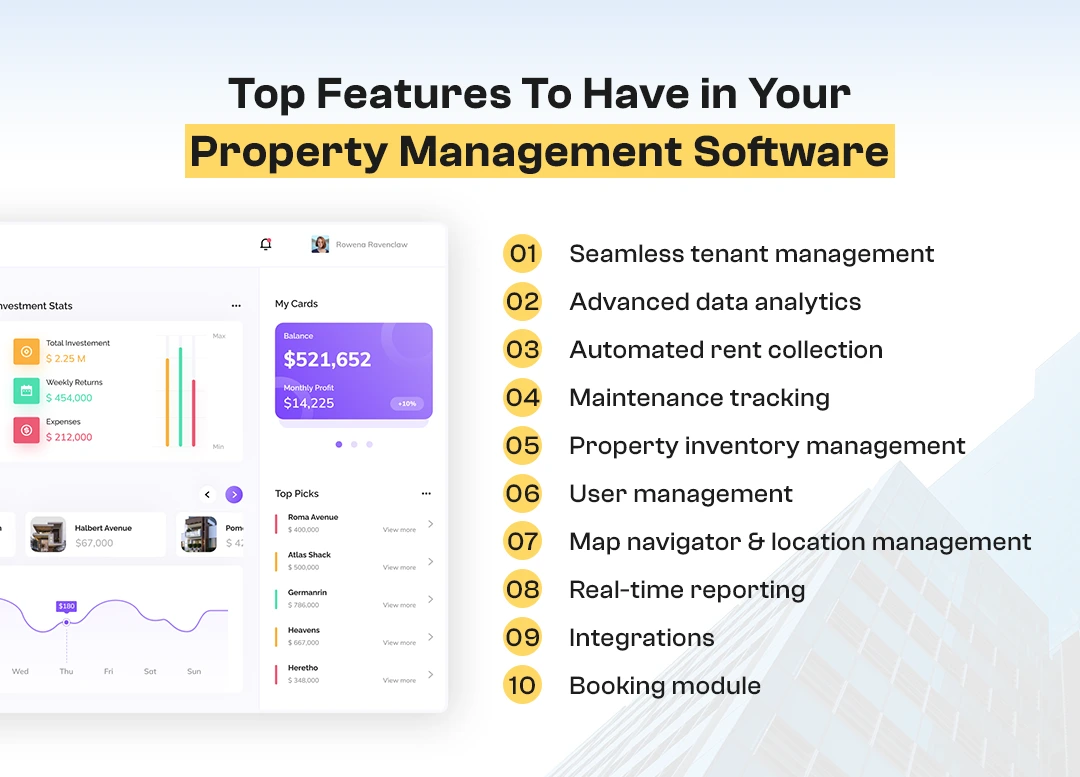
As there could be a never-ending list of features for property management software, here are some of the most important ones to consider when selecting a system.
Seamless Tenant Management:
Make sure it’s easy to manage your tenants from the software. Include features like profiles, rental agreements, and tracking. With a seamless interface and reliable data tracking, you’ll save yourself a lot of time and energy. Furthermore, you’ll have the ability to access tenant information quickly when needed.
Advanced-Data Analytics:
Gather comprehensive data to get a better understanding of your business performance. With advanced analytics, you can easily track rental payments and develop strategies to increase your profits. You can also integrate the data with other systems, allowing you to create comprehensive reports that can help you identify trends and areas of improvement.
Automated Rent Collection:
Set up a system that automatically collects rent payments from tenants. Include features like payment reminders, auto payments, and easy tracking for rental payments. This will save you time, as you won’t have to collect rent each month manually. Moreover, it minimizes the risk of missed or late payments.
Maintenance Tracking:
The ability to keep track of maintenance requests and schedule repairs is essential for property management software. A good system should include features like scheduling, tracking, and reporting on maintenance tasks. This will help ensure that any issues are addressed quickly and efficiently.
Property Inventory Management:
The software should be able to track all of the assets on a property. This includes furniture, appliances, and other items. This feature will help you keep track of all the assets and make sure that nothing is lost or damaged. Also, it will help to ensure that all items are adequately insured.
User Management:
Have the ability to add and remove users from your property management system. Include features like user profiles and permission levels so that you can define who has access to certain areas of the system. This will ensure that only those with authorization are able to access sensitive information.
Map Navigator And Location Management:
Have a map and navigation feature that allows you to manage multiple properties from one platform. It should also include features such as location tracking, route optimization, and geofencing. This will save you time and energy when it comes to managing your properties.
Real-Time Reporting:
Be able to generate reports in real-time with accurate data. Include features like customizable dashboards and comprehensive analytics so that you can easily monitor your business performance. This will give you an overview of how your properties are doing and help you identify areas for improvement.
Integrations:
Make sure the system supports integrations with third-party services like accounting systems, banking, and payment processing. With these features, you’ll be able to access the information you need and make better-informed decisions easily.
Booking Module:
Include a booking module to streamline the process of renting out your properties. It should include features like calendar management, payment processing, and customer communication tools so that you can easily manage bookings. This will save you time and help make sure that all of your visitors have a pleasant experience.
These are just some of the top features that you should look for in your property management software. On this note, it’s essential to know what the cost would be to develop a custom PMS for your business.

Cost To Develop a Bespoke Property Management System:
A bespoke property management system is a custom-built software solution tailored to meet the requirements of an individual business. The cost will vary based on the features that you want to include, the complexity and size of the system, as well as the development team you hire for the job.
On average, the cost of developing a custom property management system is between $35,000 to $250,000, and the price is determined by multiple factors:
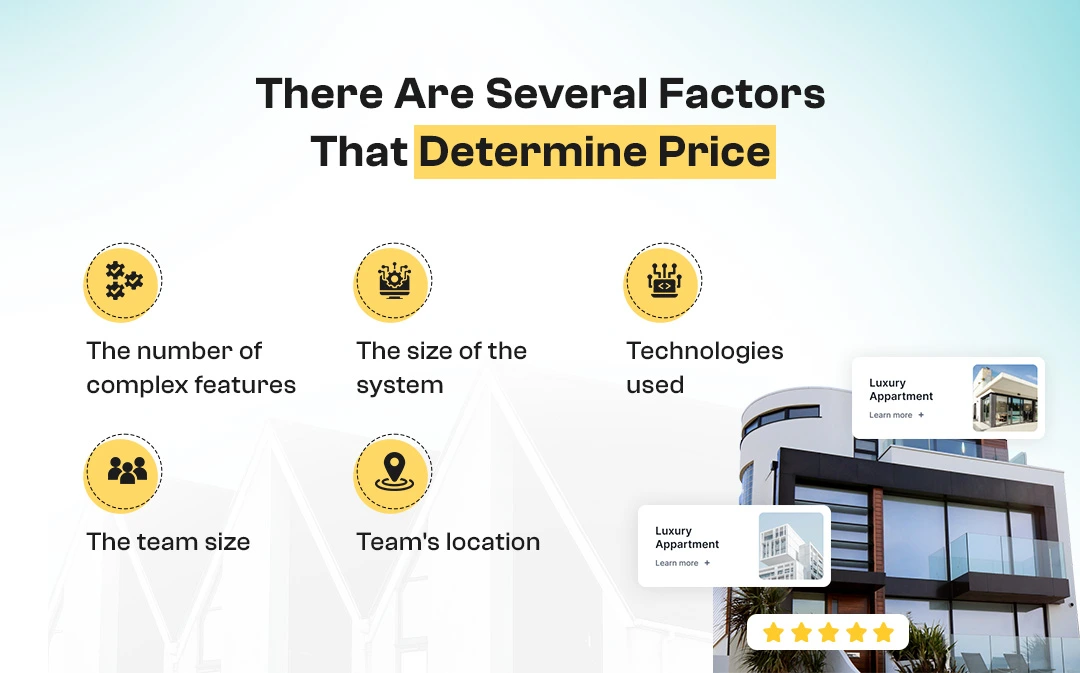
The Number Of Complex Features:
The first aspect that will determine the cost of building a custom property management system is the number of features that you want to include in your project. The more intricate features that you require, the more expensive it becomes to develop your system. For example, if you need a component that is capable of tracking rental payments, it will require more development effort than simply providing basic information about each tenant.
The Size Of The System:
The size of a property management system is an essential factor, as it can significantly increase the cost of development. If you are managing a large portfolio of properties, your custom solution will need to handle a lot of data and complex operations. This will require more development time and resources, adding to the overall cost of the project.
Technologies Used:
The cost of developing a custom property management system is also dependent on the technologies used in its development. If you are using technologies like blockchain, AI, virtual reality or machine learning, the cost of the project will be higher as these technologies require specialized knowledge and experience to implement.
The Team Size:
The size of the development team will also influence the cost of developing a custom property management system. Depending on the complexity of your project, you may require a larger team of developers to complete it in an efficient manner. This can increase the cost significantly as you will need more resources and labor to deliver results.
Team’s Location:
The location of the development team is another critical factor in determining the cost of developing a custom property management system. Generally, software development teams located in countries with low labor costs are more affordable than those located in developed countries like the US and UK.
Thus, it becomes essential to hire an experienced custom app development company like AGS that has the expertise to provide cost-effective solutions and develop a custom property management system that meets your specific requirements.
Why Choose Auxano Global Services for Custom PMS Development?
AGS is a top software development agency that specializes in creating custom software solutions for businesses. We have a team of highly experienced developers who are well-versed with the latest technologies and real estate industry trends.
Our developers have years of experience in building custom property management systems that are tailored to meet the exact requirements of businesses. We understand how important it is for a real estate business to have an efficient system that can manage the entire property portfolio in one place.

Wrapping Up!
Developing a custom property management system is an essential investment for any real estate business. It requires careful consideration of multiple factors to ensure that you get the best value for money. Hiring a professional software development company like AGS is the best way to make sure that your custom solution meets all your requirements and is delivered on time.
Frequently Asked Questions
-
1. How much does it cost to build a custom property management system?
The cost of developing a custom property management system depends on multiple factors, such as the number of factors and, in general, the project size, technologies used, and team size. The cost can range anywhere from $35,000 to $250,000.
-
2. What features should be included in a custom PMS?
You should include features like tenant tracking, rental payment tracking, contract management, maintenance scheduling, and reporting in your custom property management system. Also, you can also have features like rent management and analytics to make the system more efficient.
-
3. What is the best way to manage a large portfolio of properties?
The best way to manage an extensive portfolio of properties is to use a custom property management system. This will enable you to manage all your properties in one place, streamline processes and improve efficiency.
-
4. How long does it take to develop a custom PMS?
The development time for a custom property management system depends on the complexity of the project. On average, it can take anywhere from 6 to 12 months for a custom PMS to be developed and tested.
-
5. Is developing a custom PMS worth the investment?
Yes, developing a custom property management system is worth the investment as it helps to improve efficiency and streamline processes. It also enables you to manage all your properties in one place and access essential data quickly.



![Best Retail Industry Software Solutions to Develop an Omnichannel Presence [2021]](https://www.auxanoglobalservices.com/agsresources/wp-content/uploads/2021/08/Best-Retail-Industry-Software-Solutions-to-Develop-an-Omnichannel-Presence-AGS.jpg)

